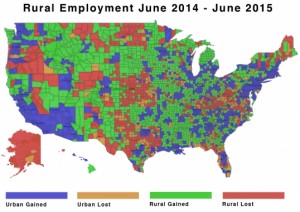
By Elizabeth Zach, RCAC staff writer
Several areas across the rural West saw noticeable gains in employment in the year preceding June 2015, but others, such as Alaska, suffered losses in the same period, keeping that state’s jobless rate above the national average.
According to Bureau of Labor Statistics data released last week, rural employment has continued to climb since the spring. The report also showed that between June 2014 and June of this year, two out of every three rural counties gained jobs.
In the rural West, these shifts occurred mostly in northern California, coastal Washington, much of Idaho, Nevada, Wyoming, as well as western Montana and eastern Colorado.
In eastern Arizona, four out of five rural counties – Navajo, Apache, Gila and Graham – reported employment gains of between 7.4 and 13.6 percent. This was particularly noteworthy when compared to the state overall, which showed a 5.9 percent increase in the number of residents looking for work.
Similarly, California had an employment boost this quarter, with 115,797 new jobs. Part of this jump was seen in the state’s northern rural areas, with 18 counties reporting increased employment. However three rural counties – Inyo, Mono and Trinity – reported job losses.
In Wyoming’s 23 counties, both rural and urban communities saw increased employment, with just one urban county – Natrona, where Casper is the county seat – reporting 81 job losses. Four rural counties reported declines in employment, but 17 others had job gains.
However, both Oregon and Alaska experienced noticeable employment losses. In Oregon, five coastal counties – Lincoln, Coos, Clatsop, Douglas and Tillamook – saw declines of between 5.5 and 7.6 percent. And in the state’s sparsely populated eastern border area just four of 17 rural counties reported employment gains.
Of Alaska’s 20 boroughs, 18 are rural and every one of them reported job losses. So did the two urban boroughs of Matanuska-Susitna and Fairbanks North Star. The state’s unemployment rate, at 6.8 percent, hovers above the national average, which is 5.5 percent.
But one economist for the state took a longer view of the numbers, saying that labor statistics can be misleading for less populated states such as Alaska.
“We’re frustrated by these estimates because they don’t give an accurate picture of what’s happening,” said Caroline Schultz, an economist with Alaska’s Department of Labor and Workforce Development. “One issue is manufacturing, which in Alaska is mostly seafood processing. That is very seasonal work, which contributes to a statewide decline. But in June, when this latest report ends, salmon season picks up. So, these estimates should be taken with a grain of salt.”
